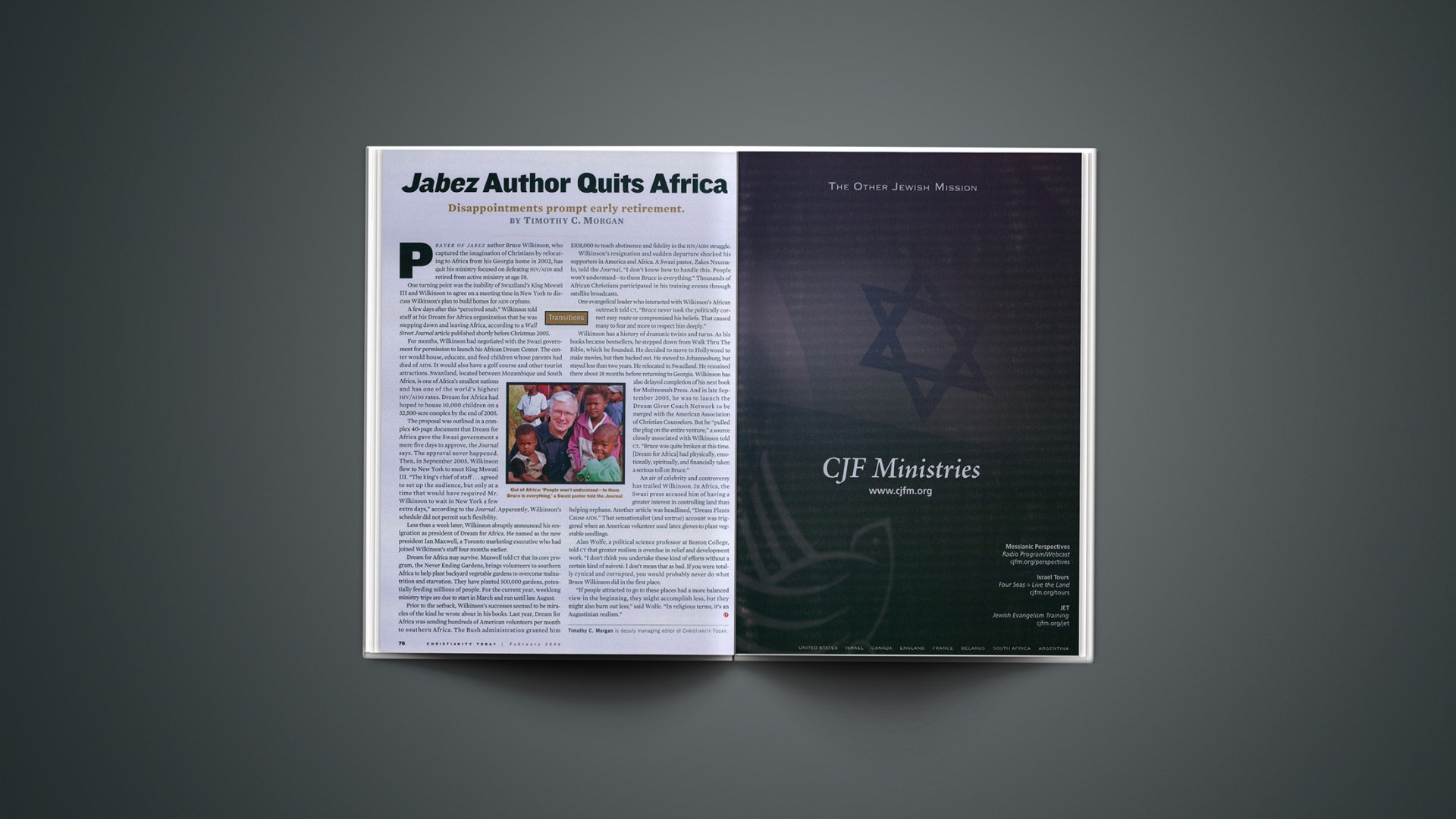Prayer of Jabez author Bruce Wilkinson, who captured the imagination of Christians by relocating to Africa from his Georgia home in 2002, has quit his ministry focused on defeating HIV/AIDS and retired from active ministry at age 58.
One turning point was the inability of Swaziland’s King Mswati III and Wilkinson to agree on a meeting time in New York to discuss Wilkinson’s plan to build homes for aids orphans.
A few days after this “perceived snub,” Wilkinson told staff at his Dream for Africa organization that he was stepping down and leaving Africa, according to a Wall Street Journal article published shortly before Christmas 2005.
For months, Wilkinson had negotiated with the Swazi government for permission to launch his African Dream Center. The center would house, educate, and feed children whose parents had died of AIDS. It would also have a golf course and other tourist attractions. Swaziland, located between Mozambique and South Africa, is one of Africa’s smallest nations and has one of the world’s highest HIV/AIDS rates. Dream for Africa had hoped to house 10,000 children on a 32,500-acre complex by the end of 2005.
The proposal was outlined in a complex 40-page document that Dream for Africa gave the Swazi government a mere five days to approve, the Journal says. The approval never happened. Then, in September 2005, Wilkinson flew to New York to meet King Mswati III. “The king’s chief of staff … agreed to set up the audience, but only at a time that would have required Mr. Wilkinson to wait in New York a few extra days,” according to the Journal. Apparently, Wilkinson’s schedule did not permit such flexibility.
Less than a week later, Wilkinson abruptly announced his resignation as president of Dream for Africa. He named as the new president Ian Maxwell, a Toronto marketing executive who had joined Wilkinson’s staff four months earlier.
Dream for Africa may survive. Maxwell told CT that its core program, the Never Ending Gardens, brings volunteers to southern Africa to help plant backyard vegetable gardens to overcome malnutrition and starvation. They have planted 500,000 gardens, potentially feeding millions of people. For the current year, weeklong ministry trips are due to start in March and run until late August.
Prior to the setback, Wilkinson’s successes seemed to be miracles of the kind he wrote about in his books. Last year, Dream for Africa was sending hundreds of American volunteers per month to southern Africa. The Bush administration granted him $108,000 to teach abstinence and fidelity in the HIV/AIDS struggle.
Wilkinson’s resignation and sudden departure shocked his supporters in America and Africa. A Swazi pastor, Zakes Nxumalo, told the Journal, “I don’t know how to handle this. People won’t understand—to them Bruce is everything.” Thousands of African Christians participated in his training events through satellite broadcasts.
One evangelical leader who interacted with Wilkinson’s African outreach told CT, “Bruce never took the politically correct easy route or compromised his beliefs. That caused many to fear and more to respect him deeply.”
Wilkinson has a history of dramatic twists and turns. As his books became bestsellers, he stepped down from Walk Thru The Bible, which he founded. He decided to move to Hollywood to make movies, but then backed out. He moved to Johannesburg, but stayed less than two years. He relocated to Swaziland. He remained there about 18 months before returning to Georgia. Wilkinson has also delayed completion of his next book for Multnomah Press. And in late September 2005, he was to launch the Dream Giver Coach Network to be merged with the American Association of Christian Counselors. But he “pulled the plug on the entire venture,” a source closely associated with Wilkinson told CT. “Bruce was quite broken at this time. [Dream for Africa] had physically, emotionally, spiritually, and financially taken a serious toll on Bruce.”
An air of celebrity and controversy has trailed Wilkinson. In Africa, the Swazi press accused him of having a greater interest in controlling land than helping orphans. Another article was headlined, “Dream Plants Cause aids.” That sensationalist (and untrue) account was triggered when an American volunteer used latex gloves to plant vegetable seedlings.
Alan Wolfe, a political science professor at Boston College, told CT that greater realism is overdue in relief and development work. “I don’t think you undertake these kind of efforts without a certain kind of naiveté. I don’t mean that as bad. If you were totally cynical and corrupted, you would probably never do what Bruce Wilkinson did in the first place.
“If people attracted to go to these places had a more balanced view in the beginning, they might accomplish less, but they might also burn out less,” said Wolfe. “In religious terms, it’s an Augustinian realism.”
Timothy C. Morgan is deputy managing editor of
Christianity Today
.Copyright © 2006 Christianity Today. Click for reprint information.
Related Elsewhere:
The Wall Street Journal report on Wilkinson is available online for subscribers.
Christianity Today‘s cover story on Wilkinson includes:
Mr. Jabez Goes to Africa | Bruce Wilkinson expands his borders to include racial reconciliation and HIV/AIDS. (Oct. 17, 2003)
Never-Ending Gardens | Bruce Wilkinson and his son teach the hungry to feed themselves. (Oct. 17, 2003)
CT’s managing editor, Mark Galli, reviewed Wilkinson’s The Prayer of Jabez and The Secrets of the Vine.
More on ministry in Africa is available from our World Report.










